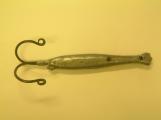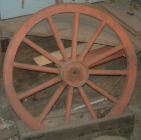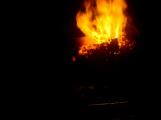15
At the forge the blacksmith was responsible for making and placing the iron bands on the cart wheels in order to protect the wood from being damaged by rocks.Fitting wooden wheels with iron tyres/rims was a process which used to be regularly undertaken by the smith. A lot of skill and experience was needed to produce a good result. To fit a tyre to a new wheel, the perimeter of the wooden wheel is first measured with a traveller. The smith makes an allowance for the shrinkage that is needed in the final work and cuts a length of flat iron bar. This measuring must be correct and an experienced smith checks everything three times before cutting.
The bar is then formed into a circle using the tyre bender and the ends are welded together to make a hoop. A furnace or a large fire of waste wood on the open ground is needed to heat the hoop for the tyring. The wheel is then clamped onto the iron wheelplate that is set in the front of the forge, or sometimes outside the forge. When the tyre is heated to the right temperature it is lifted from the fire and lowered over the rim of the wheel. The smith levers the tyre over the rim with iron tyre dogs and helpers follow with sledgehammers to drive the tyre well onto the wheel. When it is evenly fitted, water is poured around the work and amidst the steam the woodwork joints are forced together as the iron shrinks on to the wheel.
Source: The Village Blacksmith by Jocelyn Bailey, Shire Publications Ltd. 1977
17
The hearth and fire form the forge proper although today the word forge refers to the whole workspace of the blacksmith. The fire is on a raised hearth, usually of bricks, with a hood and chimney over it. The bellows on the back of the hearth creates the air that is required to bring the fire to a sufficient temperature to heat the iron for working. A blast pipe projects into the fire and is connected to the bellows by a pipe that is cooled by the water tank behind the hearth. Fuel for the fire is suppied by coal.Coal was delivered to Trinity twice a year by boat. Some coal used to have a lot of clinkers in it and was a nuisance to work with but the smith could keep the fire in good working condition by using the rake and poker to get rid of clinker.
When it comes to lighting the fire the first task is to clean out the old fire right down to the air nozzle. Into this cavity area, no bigger than a teapot, the smith packed a deep layer of dry wood shavings. Then he laid on some splinters of dry wood, leaving some air spaces between them. The hardwood would hold the heat long enough for the coal to catch. Then the smith would light the fire. The shavings burned fast and soon the shavings were crackling and the kindling settled into the hole and the wood would catch fire, the blacksmith then gently raked coal in over the fire. When the coal was burning well, the smith caught the bellows lever and pumped a bit of draft into the hearth and the fire would begin to glow red. The wood kindling was burnt by now and the fire had come to life. The work would then begin. As the coal burns out and turns to ash, fresh fuel was raked in from the edges, never being directly placed on top.
When the smith leaves the forge, he would place a piece of old dry wood on the fire to hold the heat of the fire until he returned. Even if the fire had died it could often be revived by sprinkling a handful of sawdust on the coals as long as the coals were hot enough to "smoke sawdust" the fire could be brought back to life.
Source: The Blacksmith: Ironworker and Farrier by Aldren A. Watson
18
The following photographs are of blacksmith Wade Ivany completing some work at the anvil.19
Blacksmith Wade Ivany hammering out the point on a pick axe to make it sharp again.6 August 2004
Green Family Forge,Trinity, Newfoundland and Labrador, Canada

20
Blacksmith Wade Ivany hammering out a piece of metal to make a fire place poker6 August 2004
Green Family Forge,Trinity, Newfoundland and Labrador, Canada

21
In 2002 the Trinity Historical Society began to offer an apprentice program at the Green Family Forge with the financial assistance of the Young Canada Works in Heritage Institutions Program that is offered through the Department of Canadian Heritage and is administered by the Canadian Museums Association.Under the program the Society has been able to hire during the summer months for the past three years a student who has an interest in blacksmithing, and who is pursuing a related field in a post-secondary education program. In this program with the guidance of the blacksmith the young person learns the basics of the trade, including the history of blacksmithing, tool identification and maintenance and the manufacturing of hardware.
One of the apprenctices, Joshua Hookey in 2002 said, "It's a great job working with metal. You can take the metal and make anything out of it. Metal's a bit like bubble gum because it can go in any shape."
The pictures that follow show the apprentice for the past two years, Daniel Johnson, who is pursuing an education in Mechanical Engineering.
Did you Know?
Apprenticing in blacksmithing has been taking place for years. Many sons apprenticed under their fathers before taking over the business, such was the case with the Green family. Apprenticeships would usually last for three or four years.
Apprentices were needed as it was next to impossible at times for the smith to make or repair large items on his own so there was always an apprentice or a striker who worked with the blacksmith. The apprentice got the name striker from carrying out the following activity: the smith would stand on one side of the anvil, and the apprentice on the other. When the smith pulled the iron out of the fire the apprentice would strike the iron with the hammer or maul, thus the name striker was given to the apprentice.
22
Blacksmith apprentice Daniel Johnson6 July 2004
Green Family Forge,Trinity, Newfoundland and Labrador, Canada
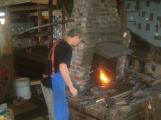
23
The apprentice works on a fireplace poker.6 July 2004
Green Family Forge,Trinity, Newfoundland and Labrador, Canada

24
Blacksmith Apprentice Daniel Johnson making a fireplace poker6 July 2004
Green Family Forge,Trinity, Newfoundland and Labrador, Canada
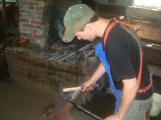
25
Daniel Johnson, Blacksmith Apprentice, carrying out some work on the fireplace poker on the anvil.6 July 2004
Green Family Forge,Trinity, Newfoundland and Labrador, Canada
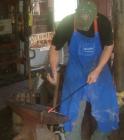
26
The following group of pictures show some of the items that are handcrafted at the Green Family Forge by our blacksmith and blacksmith apprentice using the traditional methods and tools of the trade.We encourage you to visit our website: www3.nf.sympatico.ca/ttci to learn more about the work of the Trinity Historical Society, the Green Family Forge and to view our line of handcrafted iron products that we have for sale.
27
Cod Jigger Coat Hook6 December 2004
Green Family Forge,Trinity, Newfoundland and Labrador, Canada
